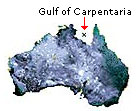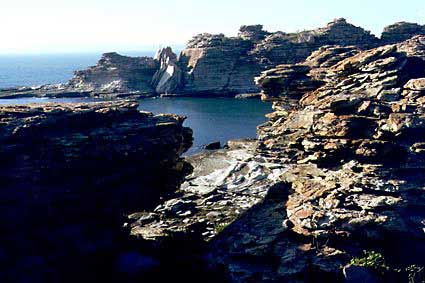

|
The Gulf of Carpentaria is the large bay shared by the Northern Territory and Queensland, Australia (north central Australia). The Gulf is separated from the Coral Sea on the northeast by the 12-m-deep Torres Strait and from the Arafura Sea on the northwest by the Arafura Sill, which lies about 53 m below the sea surface. The Gulf is a macrotidal, drowned river valley, and a mature estuary that is relatively shallow and flat-floored. The maximum water depth is about 70 m. It is about 480 kilometers (300 miles) wide and 640 kilometers (400 miles) long. The waters are shallow in most areas. Mudflats and mangrove swamps lie along its shores. It has a tidal range variation of 600-1600 m. Numerous creeks and rivers drain into the Gulf.  (Photo by Ludo Kuipers © OzOutback Internet Services, http://ozoutback.com.au/) One of the remotest areas of Australia, the coastline surrounding the Gulf is virtually all Aboriginal land. Blackrocks Landing at Batten Point, near Borroloola at the mouth of the Macarthur River, is a popular spot for fishermen who may camp there and launch their boats, but the wide beaches at Wiyayi and Malagayangu near Numbulwar are on Aboriginal land in south eastern Arnhem Land and favoured spots for the Nunggubuyu people who come to fish and look for turtle eggs here. An interesting cloud phenomenon occurs over the Gulf of Carpentaria that has intrigued scientists, particularly meterologists. This phenomenon is called the Morning Glory of the Gulf of Carpentaria . Unique on Earth and not very well understood, the Morning Glory wave cloud arrives regularly each spring. Dynamic waves of this type occur unheralded everywhere and at all altitudes, and are the cause of much of the clear air turbulence which so disrupts commercial air travel. Those waves, however, are usually invisible, infrequent and currently all but unpredictable. Morning Glory waves sometimes exceed 1000 km in length and 10,000 feet in height. These enormous waves are believed to contain the energy equivalent of several nuclear devices. The Gulf of Carpentaria harbors two species of crocodiles, the man eating Crocodylus porosus (saltwater crocodile) and the relatively harmless freshwater variety.
|